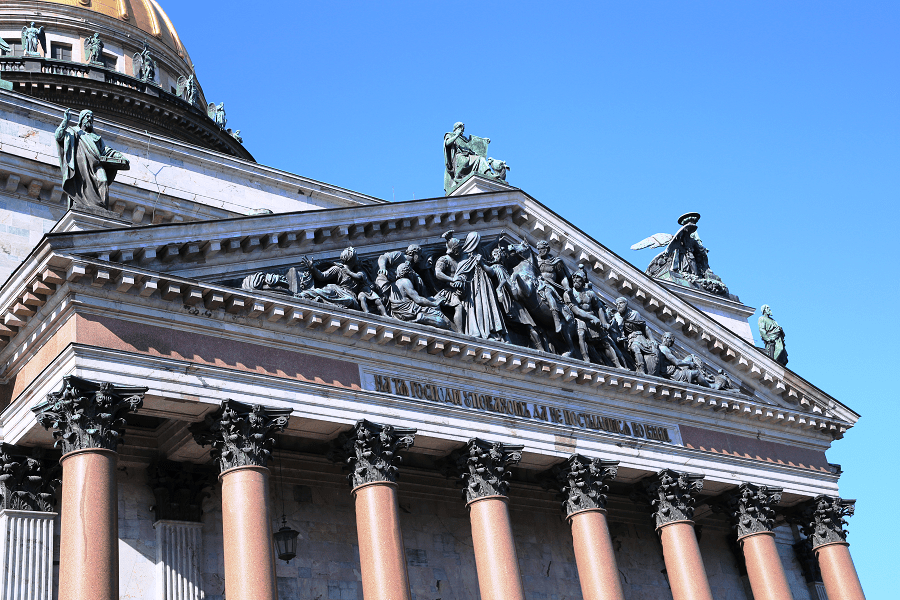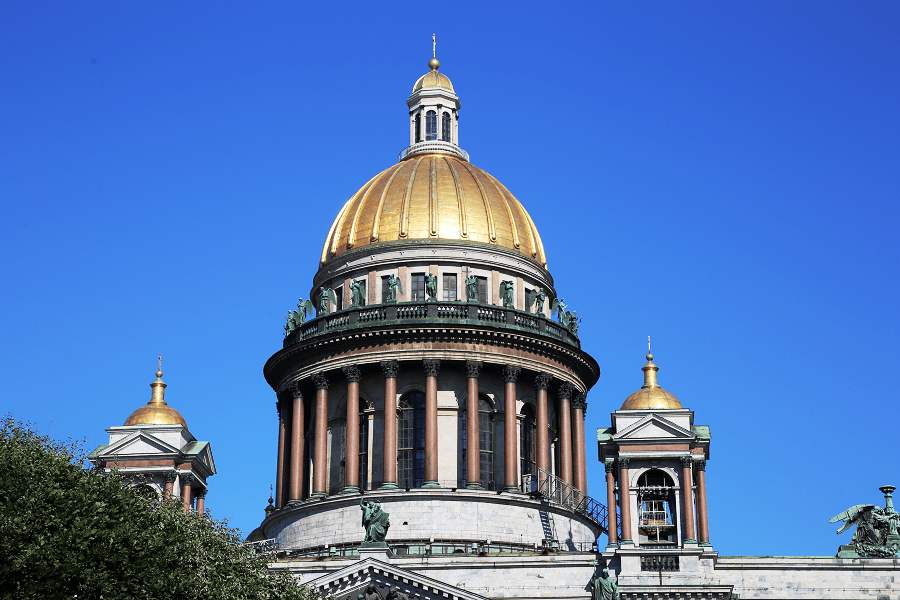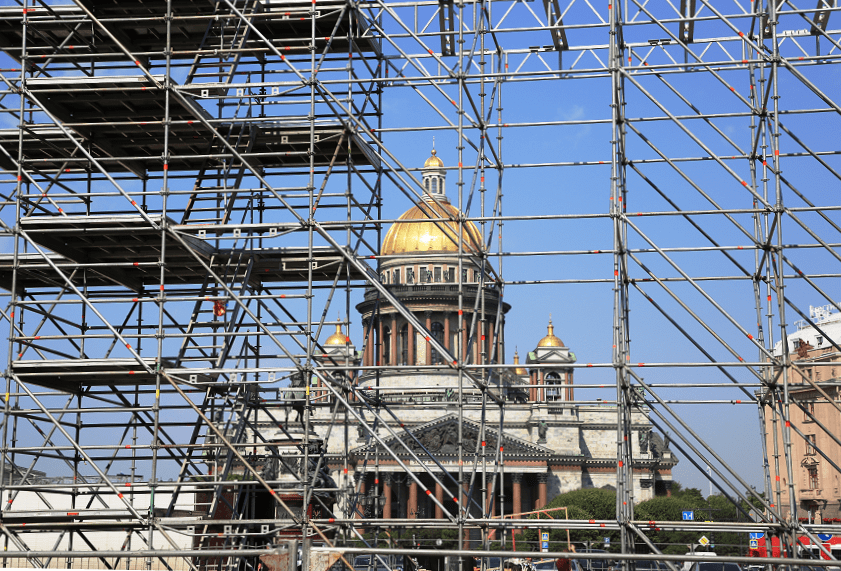St. Isaac’s Cathedral (Cathedral of St. Isaac of Dalmatia) is the second largest Russian Orthodox church (after Cathedral of Christ the Saviour in Moscow).
Located on St. Isaac’s Square in St. Petersburg.
Cathedral of the St. Petersburg diocese from 1858 to 1929. Since 1928 it has the status of a museum (the museum complex “The State Museum-Monument” St. Isaac’s Cathedral”).
The modern building of the cathedral is the fourth St. Petersburg church in honor of St. Isaac of Dalmatia, built on the site of a cathedral designed by Antonio Rinaldi. The author of the project of the fourth cathedral, which was intended to become the main Orthodox shrine of the empire, was the architect Auguste Montferrand. The construction was supervised by Nicholas I himself, the chairman of the Commission for the construction of the cathedral was Karl Opperman.
During the construction of the building, new construction technologies were used for that time, which influenced the further development of architecture in the 19th and 20th centuries. The construction of the building and work on its design continued from 1818 to 1858.
St. Isaac’s Cathedral is considered the latest building in the style of classicism.
It was consecrated in the name of the Monk Isaac of Dalmatia, revered as a saint by Peter I, since the emperor was born on the day of his memory – May 30 according to the Julian calendar. The solemn consecration on May 30 (June 11), 1858, of the new cathedral was performed by Metropolitan Gregory of Novgorod, St. Petersburg, Estland and Finland.
Registered in June 1991, the church community received the opportunity to worship in the cathedral. Divine services in St. Isaac’s Cathedral are held daily. The rector of the church is Metropolitan Varsonofy (Sudakov) of St. Petersburg and Ladoga.
St. Isaac’s Cathedral is an outstanding example of late classicism, also called the latest building in this style, in which new trends are already emerging (neo-Renaissance, Byzantine style, eclecticism).
The temple is five-domed with a dominating central hemispherical dome and four small domes ending with square bell towers. The belfries are located in 4 small domes on the sides of the large one (in the 19th century, 11 bells were cast for the temple by the Valday master I.M. Stukolkin, the largest of them weighed about 29 tons).
The large dome is crowned with an octagonal lantern. The facades are decorated with porticos of the Corinthian order – from the north and south, more solemn, sixteen-column, overlooking the square, from the east and west – eight-column porticos.
The main entrance, in violation of the rules, is located in the western portico, and has no eastern entrance. The triangular pediments are decorated with sculptural groups. The building is rectangular in plan, taking into account the porticoes, its outline is an almost equal-ended cross.
The cathedral stands on a plinth, a stereobath with two wide steps. The building is connected with the tradition of Orthodox architecture only by its five domes and central layout.
The height of the cathedral is 101.5 m, length (including porticos) 111.3 m, width – 97.6. The outer diameter of the dome is 25.8 m, the inner diameter is 21.8 m. The building is decorated with 112 monolithic granite columns of various sizes. The walls are lined with light gray Ruskeala marble, part of the cladding slabs, cracked due to uneven settlement of the building, were replaced during restoration work in the 1870-1890s with bardillio marble.
The cathedral is the tallest building of the architectural complex, which includes four squares of the city (Admiralty, Palace square, St. Isaac’s and Senate) and facing the Neva in the north. The axis of the building, located deep in St. Isaac’s Square, coincides in the north-south direction with the axis of the square.
On the north side of Isaac there is the Alexander Garden, and on the opposite, south, square, which was laid out immediately after the completion of the construction of the cathedral. Due to its position, the cathedral is perfectly visible from all sides; in the distance, some disproportion of the building and the massiveness of the sculptural decoration are hidden.
The best view of Isaac opens from the University embankment on Vasilyevsky Island.
The cathedral rises framed by the facade of the Admiralty with a boulevard (left) and the buildings of the Senate and Synod with an arch (right). Isaac serves as a backdrop for the monument to Peter I, the panorama is limited at the bottom of the Neva embankment, and the bell towers and the golden dome are reflected in its waters. With its monumental forms and richness of decoration, the cathedral rises above the buildings of the square and even “overwhelms with its architectural power”.
The cathedral’s main dome rises 101.5 metres; its exterior is gilded. The dome is decorated with twelve statues of angels by Josef Hermann. These angels were likely the first large sculptures produced by the then novel process of electrotyping, which was an alternative to traditional bronze casting of sculptures. Montferrand’s design of the dome is based on a supporting cast iron structure. It was the third historical instance of cast iron cupola after the Leaning Tower of Nevyansk (1732) and Mainz Cathedral (1826).
With an internal height of 69 m (from the floor to the level of the oculus), it ranks among the tallest domes in the world.
The cathedral’s bronze doors, covered in reliefs by Ivan Vitali, are patterned after the celebrated doors of the Battistero di San Giovanni in Florence, designed by Lorenzo Ghiberti. Suspended underneath the peak of the dome is a sculpted white dove representing the Holy Spirit. Internal features such as columns, pilasters, floor, and statue of Montferrand are composed of multicolored granites and marbles gathered from all parts of Russia. The iconostasis is framed by eight columns of semiprecious stone: six of malachite and two smaller ones of lazurite. The four pediments are also richly sculpted.
The interior was originally decorated with scores of paintings by Karl Bryullov and other great Russian masters of the day. When these paintings began to deteriorate due to the cold, damp conditions inside the cathedral, Montferrand ordered them to be painstakingly reproduced as mosaics, a technique introduced in Russia by Mikhail Lomonosov. This work was never completed.
In 2012, the reconstruction of the bells, destroyed around 1930, began. The first bell weighing about 10 tons was cast in 2012. In 2013, 14 bells were made in Voronezh and brought to St. Petersburg, intended for the southeastern bell tower. In 2015, Bishop Markell of Tsarskoye Selo consecrated the last 16th bell of the updated scale weighing about 17 tons – the bell was installed on the northwestern bell tower of the cathedral. During the procession, all 16 bells installed on the three bell towers of the cathedral are used.
In 2018, St. Isaac’s Cathedral, according to the results of voting, was chosen as the Orthodox symbol of St. Petersburg.
Working days
Museum-monument “St. Isaac’s Cathedral”
From 10:00 to 18:00
(ticket office from 10:00 to 17:30)
Day off – Wednesday
Evening programs of the museum
from May 01 to September 30:
from 18:00 to 21:30 without excursion service,
kiosk for the sale of printing and souvenir products from 18:00 to 21:30,
work of cash desks and admission of visitors from 18:00 to 21:00.
Day off Wednesday.
Colonnade of St. Isaac’s Cathedral
From 10:00 to 18:00.
(from May 01 to September 30 – seven days a week; from October 01 to April 30, a day off – the third Wednesday of the month)
Evening colonnade
from May 01 to September 30:
from 18:00 to 21:30,
work of cash desks and admission of visitors from 18:00 to 21:00.
Seven days a week.
Museum-monument “Savior on Spilled Blood“
From 10:00 to 18:00
(ticket office from 10:00 to 17:30)
Day off – Wednesday
Evening programs of the museum
from May 01 to September 30:
from 18:00 to 21:30 without excursion service,
kiosk for the sale of printing and souvenir products from 18:00 to 21:30,
work of cash desks and admission of visitors from 18:00 to 21:00.
Day off – Wednesday.
Chapel-museum (chapel of the Savior on Spilled Blood Museum
From 10:00 to 18:00 (from May 01 to September 30 without days off; from October 01 to April 30, a day off – the second Wednesday of the month).
How to get to?
Address: St. Isaac’s Square, 4
Metro station “Admiralteyskaya”
Buses 3, 22, 27
Trolleybuses 5, 22
Museum-monument “The Savior on Blood”
Address: Griboedov Canal Embankment, 2b, letter A
Nevsky Prospekt metro station (exit to the Griboyedov Canal)
Buses 3, 7, 22, 27
Trolleybuses 1, 5, 7, 10, 11, 22




















